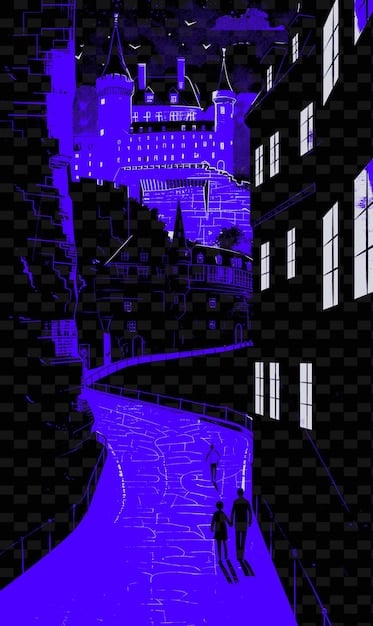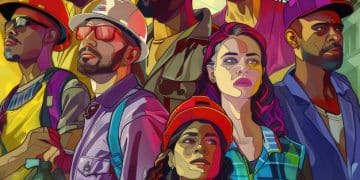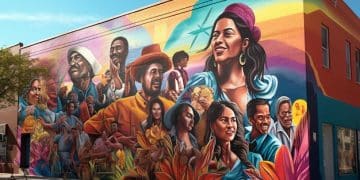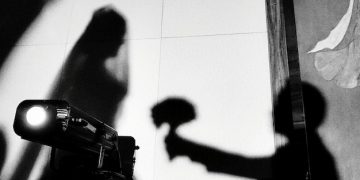Hip Hop Wordplay: Decoding Complex Messages in Lyrics

Hip Hop artists masterfully employ intricate **wordplay** to embed profound **messages** within their lyrics, challenging listeners to delve deeper into the multifaceted narratives of culture, society, and personal introspection, transforming mere songs into rich textual tapestries.
Decoding the Lyrics: How Hip Hop Artists Are Using Wordplay to Convey Complex Messages isn’t just about understanding what’s said, but how it’s said. Hip Hop, more than any other genre, elevates language to an art form, where every word, every rhyme, and every cadence is meticulously crafted to carry layers of meaning. This linguistic dexterity transforms songs into intricate puzzles, inviting listeners to peel back layers to uncover profound insights, social commentary, and personal narratives. It’s a testament to the genre’s intellectual prowess and its unique ability to communicate beyond the obvious, creating a rich tapestry of sound and sense that resonates deeply with its audience.
The Art of Lyrical Concealment: Metaphor and Simile
The foundation of complex lyrical messaging in Hip Hop often lies in the sophisticated use of metaphor and simile. These literary devices allow artists to draw unexpected connections, comparing disparate concepts to illuminate deeper truths or evoke powerful imagery without explicitly stating them. It’s a subtle dance between suggestion and revelation, where the listener is actively engaged in the process of interpretation.
Artists skillfully weave these figures of speech into their narratives, transforming abstract ideas or harsh realities into digestible, yet profound, lyrical expressions. This method not only enhances the poetic quality of the music but also serves as a critical tool for conveying messages that might otherwise be too confrontational, too nuanced, or too deeply personal for direct articulation. The subtlety allows for wider interpretation and a more enduring impact on the listener.
Layering Meaning with Figures of Speech
The power of metaphor and simile in Hip Hop extends beyond mere embellishment; they serve as structural components that build intricate layers of meaning. By equating an experience with a seemingly unrelated object or concept, artists can evoke specific emotions, suggest a shared understanding, or even critique societal norms implicitly.
- Extended Metaphors: Tracks like Common’s “I Used to Love H.E.R.” personify Hip Hop as a woman, allowing for a poignant narrative about the genre’s evolution and perceived decline. This extends a single metaphor across an entire song.
- Everyday Similes: Artists often use relatable comparisons (“fly like an eagle,” “cold as ice”) to make complex feelings or situations immediately understandable, adding vividness to their storytelling.
- Socio-political Commentary: Metaphors can veil sharp critiques of systemic issues, making the message permeable to audiences who might otherwise dismiss explicit political statements.
This constant interplay between the literal and the figurative keeps listeners engaged, encouraging them to think critically about the implications of each line. It transforms passive listening into an active intellectual exercise, where deciphering the veiled meanings becomes part of the song’s appeal. This technique is a hallmark of lyrical mastery, requiring both linguistic precision and profound insight into the human condition.
The use of metaphor and simile in Hip Hop is not accidental; it’s a deliberate choice by artists to elevate their craft and ensure their messages resonate on multiple levels. By creating these linguistic bridges between the concrete and the abstract, they invite a deeper engagement with their art, transforming songs from simple auditory experiences into profound intellectual journeys. This approach ultimately enriches the listener’s understanding and appreciation for the genre’s communicative power.
Double Entendre and Puns: Crafting Multi-Layered Narratives
At the heart of Hip Hop’s lyrical sophistication lies the ingenious application of double entendre and puns. These tools are far more than mere word games; they are fundamental mechanisms that allow artists to embed multiple meanings within a single phrase, enriching narratives with cleverness, irony, and subversive commentary. This linguistic dexterity challenges listeners to engage actively, peeling back layers of meaning to fully grasp an artist’s message, which can range from playful boasts to profound social critiques.
The mastery of double entendre, in particular, speaks to an artist’s linguistic prowess, requiring a deep understanding of language nuances and cultural contexts. It’s a delicate balance of wit and precision, ensuring that both the obvious and the hidden meanings are discernible, yet not immediately thrown into plain sight. This creates a sense of discovery for the listener, transforming the act of listening into an intellectual pursuit.
The Subtle Art of Dual Meaning
Double entendre and puns enable artists to convey complex ideas without being overly didactic or explicit. They allow for an economy of words, packing layers of thought into concise lines, which is crucial in a genre often limited by rhyme schemes and rhythmic structures. The cleverness of these devices often elicits admiration, making the listener appreciate the artist’s poetic skill.
- Humor and Irony: Puns are frequently used for comedic effect, often juxtaposing serious subjects with lighthearted wordplay to create irony or alleviate tension.
- Criticism and Subversion: Double entendres can subtly critique societal norms, political figures, or rival artists, delivering sharp commentary under the guise of an innocuous statement.
- Personal Narratives: Artists often use these devices to describe personal struggles or triumphs, adding depth and complexity to their autobiographical accounts without resorting to overly direct language.
When successfully deployed, these linguistic devices make a song endlessly re-playable, as listeners discover new meanings with each listen. This depth not only speaks to the artist’s intellect but also solidifies the Hip Hop genre as a legitimate form of literary art, one that rewards careful consideration and analytical listening. It’s a continuous invitation to explore the hidden depths of language and thought.
The continuous innovation in using double entendre and puns reflects the evolving intellectual landscape of Hip Hop. Artists push the boundaries of language, creating intricate lyrical tapestries that are as challenging as they are entertaining. This commitment to linguistic precision and creative expression ensures that Hip Hop remains a vibrant and intellectually stimulating art form, always offering something new to those willing to listen closely.
Storytelling Through Scarcity: Implied Narratives and Subtext
Beyond explicit declarations, many Hip Hop artists excel in the art of implied narratives and subtext. This approach involves leaving crucial details unsaid, forcing listeners to connect the dots and infer meanings from subtle cues, suggestive imagery, and the emotional resonance of the delivery. It’s a sophisticated method that engages the listener’s imagination and interpretive skills, creating a more personal and profound connection to the music.
Artists who master this technique understand the power of silence and suggestion. They recognize that what is left unarticulated can often be more impactful than what is explicitly stated, inviting the audience to become co-creators of the story. This form of storytelling is particularly effective in addressing sensitive topics or conveying complex emotional states without resorting to overt exposition.
Building Worlds with Unspoken Words
Implied narratives allow Hip Hop artists to create richly textured worlds where the listener actively participates in filling in the blanks. This method promotes a deeper engagement with the lyrical content, as the audience moves beyond passive listening to active interpretation, making the experience more rewarding and memorable.
- Emotional Resonance: By implying feelings rather than stating them, artists allow listeners to project their own emotions and experiences onto the lyrics, fostering a powerful connection.
- Social Commentary: Subtext can be used to critique societal issues indirectly, making the commentary more palatable while allowing for deeper consideration of the underlying problems.
- Character Development: Artists can build complex characters and relationships through implied histories or untold conflicts, adding layers of psychological depth to their narratives.
This storytelling through scarcity is a testament to the Hip Hop artist’s confidence in their audience’s intelligence. It’s a deliberate choice to provide just enough information to pique curiosity, inspiring listeners to delve deeper into the narrative and uncover its hidden dimensions. This approach not only enhances the artistic merit of the music but also creates a more enduring and reflective listening experience, solidifying the genre’s expressive capacity.

The impact of implied narratives extends beyond individual tracks, often building a larger, cohesive body of work where each song adds another layer to an ongoing story. This stylistic choice underscores Hip Hop’s strength as a narrative art form, capable of conveying intricate human experiences with nuance and profound insight, demanding and rewarding close listening.
Allusions and Intertextuality: Weaving Cultural Tapestries
Allusions and intertextuality are pivotal in Hip Hop, allowing artists to weave rich cultural tapestries within their lyrics. By referencing historical events, literary works, famous figures, or other musical pieces, artists not only demonstrate their breadth of knowledge but also enrich their narratives with layers of shared cultural meaning. This practice transforms song lyrics into a complex dialogue with history, popular culture, and the broader intellectual landscape.
This sophisticated use of referencing deepens the listening experience, inviting the audience to recognize these nods and appreciate the added context or hidden commentary they provide. It’s a subtle yet powerful acknowledgment that art does not exist in a vacuum, but rather builds upon a vast network of preceding creative and historical works.
Echoes of Culture and History
The deployment of allusions and intertextuality in Hip Hop serves multiple purposes. It can be a way to pay homage, to critique, to underscore a point, or simply to display lyrical cleverness. The effectiveness of these techniques often relies on the audience’s ability to “get” the reference, creating an exclusive connection between the artist and informed listeners.
- Historical Allusions: References to civil rights movements, political events, or historical figures give gravity to contemporary issues, showing the enduring relevance of past struggles.
- Pop Culture References: Quotes or mentions of movies, TV shows, or other songs can create immediate relatability and provide a quick shorthand for complex ideas or emotions.
- Literary and Mythological Allusions: Less common but highly impactful, these references elevate the intellectual depth of lyrics, connecting Hip Hop to broader literary traditions.
By integrating these references, Hip Hop artists solidify their place within a continuum of cultural expression. They demonstrate that their art is not merely entertainment but a powerful medium for cultural commentary, historical reflection, and artistic dialogue. This continuous interplay with other texts and cultural touchstones makes Hip Hop a dynamic and intellectually stimulating genre, always inviting deeper analysis and appreciation of its vast informational networks.
The practice of alluding and interweaving texts demonstrates Hip Hop’s self-awareness and its continuous dialogue with its own history and external cultural influences. It emphasizes the genre’s role as a chronicler of culture, absorbing and reinterpreting information to create something new and profound. This constant interplay strengthens Hip Hop’s position as a vibrant artistic and intellectual force.
Phonetics and Rhythmic Complexity: Sound as Meaning
While wordplay often emphasizes semantic content, Hip Hop artists also masterfully manipulate phonetics and rhythmic complexity, where sound itself becomes a carrier of meaning. The nuanced interplay of rhyming patterns, internal rhymes, assonance, consonance, and syncopation can powerfully reinforce or subtly undermine the overt message of the lyrics. This auditory dimension adds another intricate layer to decoding the lyrics: how Hip Hop artists are using wordplay to convey complex messages.
The artistry in this domain goes beyond simply making words rhyme. It involves a precise understanding of how sounds interact to create certain emotional responses, to emphasize particular phrases, or to establish an inescapable rhythm that drives the narrative forward. This attention to the musicality of language is a defining characteristic of lyrical excellence in Hip Hop.
The Sonic Architecture of Lyrical Depth
The careful crafting of phonetic and rhythmic elements allows artists to convey feelings and meanings that words alone might not fully capture. This sonic architecture contributes significantly to the overall impact and memorability of a track, making the lyrical content resonate on a deeper, more visceral level.
- Internal Rhymes and Multi-Syllabic Rhymes: These intricate patterns create a dense soundscape that is both challenging and rewarding, often highlighting the artist’s technical skill and lyrical agility.
- Assonance and Consonance: The repetition of vowel or consonant sounds within phrases can create a sense of cohesion, emphasize certain words, or evoke specific moods, adding subtlety to the vocal performance.
- Flow and Cadence: The unique rhythm and melodic contour of an artist’s delivery can dramatically alter the perception of the lyrics, conveying urgency, calm, anger, or introspection independent of the words themselves.
The deliberate choice of sounds and the rhythmic placement of words transform the act of listening into a multi-sensory experience. It allows artists to convey not just what they are saying, but also how they feel about it, adding an emotional layer that enriches the narrative. This fusion of sound and sense is a testament to Hip Hop’s innovative approach to poetic expression, proving that the medium is as much the message as the words themselves.

Ultimately, the mastery of phonetics and rhythmic complexity elevates Hip Hop lyrics from mere spoken words to powerful auditory sculptures. This intricate attention to sound design within the lyrical structure ensures that the message is not just heard but felt, creating a holistic and deeply immersive experience for the listener. It’s a continuous exploration of language’s full expressive potential.
Narrative Arcs and Character Development: Beyond Simple Stories
Hip Hop lyrics frequently go beyond simple anecdotes, evolving into sophisticated narrative arcs complete with nuanced character development. Artists construct detailed worlds and populate them with complex individuals, often reflections of themselves or archetypes from their communities, whose journeys unfold across verses, songs, and even entire albums. This depth transforms the music from mere entertainment into compelling storytelling, offering profound insights into the human condition and societal structures.
The challenge lies in conveying these elaborate narratives within the confines of song structures, requiring immense lyrical discipline and creativity. Artists must skillfully balance vivid imagery, dialogue, and internal monologues to bring their characters and their evolving stories to life, inviting listeners to invest emotionally in their struggles and triumphs.
The Evolution of Lyrical Narratives
The development of narrative arcs and characters in Hip Hop is not just about conveying a plot; it’s about exploring themes of identity, struggle, resilience, and transformation. This approach allows artists to tackle weighty subjects with honesty and originality, making their stories resonate deeply with a diverse audience.
- Personal Evolution: Many artists use their own lives as raw material, documenting their growth from challenging beginnings to success, or exploring continuous personal and artistic struggles.
- Societal Commentary: Characters are often used to embody the experiences of marginalized communities, serving as allegories for broader societal issues like poverty, injustice, or systemic oppression.
- Interwoven Tales: Concept albums or recurring character motifs across different tracks can create a vast, interconnected universe, encouraging deeper engagement and analysis from listeners.
By engaging in robust narrative construction and character development, Hip Hop artists establish themselves as modern-day griots, chronicling contemporary experiences with poetic flair and unfiltered honesty. This commitment to storytelling ensures that their music remains relevant and impactful, providing listeners not just with beats and rhymes, but with enduring narratives that reflect and critique the world around them. It is a testament to the genre’s capacity for profound artistic expression and its power to convey universal human experiences through specific contexts.
This sophisticated approach to narrative allows Hip Hop to transcend its musical form, becoming a potent vehicle for social realism and psychological exploration. It solidifies its place as a crucial contemporary art form, capable of both reflecting and shaping cultural dialogue through its compelling and deeply developed lyrical content. The commitment to storytelling ensures its lasting legacy.
Impact on Language and Culture: A Linguistic Revolution
The intricate wordplay and complex messaging in Hip Hop have had a seismic impact on language and culture, instigating what can accurately be described as a linguistic revolution. The genre has not only introduced countless new words and phrases into the global lexicon but has also fundamentally reshaped how language is used, perceived, and valued, especially among younger generations. This influence extends far beyond music, permeating everyday conversation, advertising, and even academic discourse.
Artists, through their innovative lyrical techniques, constantly push the boundaries of linguistic expression, demonstrating the immense flexibility and dynamism of English (and other languages) when subjected to creative pressure. This ongoing process of linguistic innovation reflects Hip Hop’s role as a cultural vanguard, continually evolving and influencing the broader communicative landscape.
Reshaping Lexicons and Communication
The profound effect of Hip Hop on language stems from its organic, street-level origins and its rapid global dissemination. It’s a genre that thrives on inventive language, often born from specific cultural contexts but quickly adopted and adapted by diverse audiences worldwide.
- Coinage of New Terms: Hip Hop has spawned a vast new vocabulary, with terms like “bling,” “flow,” “crunk,” and “woke” becoming commonplace far beyond the genre’s initial audience.
- Grammatical Innovation: Artists often bend or break traditional grammatical rules, creating new syntax and sentence structures that contribute to the unique feel and rhythm of Hip Hop speech.
- Rhetorical Influence: The argumentative and persuasive style of battle rap, for example, has influenced public speaking and debate, demonstrating a sophisticated approach to rhetoric.
The cultural impact of Hip Hop’s linguistic innovations is undeniable. It has democratized language, showing that powerful and resonant communication doesn’t always adhere to academic norms. Instead, it can emerge from the streets, from lived experience, and from a deep understanding of how words can resonate emotionally and intellectually. This linguistic revolution continues to shape how we express ourselves and how we understand the complex interplay between language, identity, and social power.
This linguistic revolution orchestrated by Hip Hop underscores its power as a cultural force, not just an entertainment genre. By constantly innovating with language, artists provide a real-time example of how words evolve, adapt, and gain new meanings, making Hip Hop a living laboratory for the study of contemporary communication and cultural identity.
| Key Aspect | Brief Description |
|---|---|
| 🎤 Metaphor & Simile | Artists use comparisons to inject deep meaning and rich imagery, transforming abstract concepts into vivid lyrical expressions. |
| 💬 Double Entendre & Puns | Clever wordplay conveying multiple meanings, adding wit, irony, and subtle commentary to narratives. |
| 📝 Implied Narratives | Storytelling relies on subtext and unspoken details, engaging listeners’ imagination to infer deeper meanings. |
| 🎵 Phonetics & Rhythm | Sound manipulation and rhythmic choices powerfully reinforce or subtly alter the lyrical message. |
Frequently Asked Questions About Hip Hop Lyrical Complexity
▼
Hip Hop artists employ complex wordplay to enrich their narratives, convey intricate messages, and showcase their linguistic skill. This allows them to express nuanced ideas, critique societal issues subtly, and build multi-layered stories that resonate deeply with listeners, making the music more engaging and thought-provoking.
▼
Metaphors and similes enhance lyrical depth by drawing connections between seemingly unrelated concepts, enabling artists to describe abstract emotions or complex situations vividly. They allow for poetic expression that transforms ordinary experiences into profound insights, inviting listeners to interpret hidden meanings and engage with the text on a deeper level.
▼
Double entendre plays a crucial role by packing multiple meanings into a single phrase, adding wit, humor, and often subversive commentary. It challenges listeners to uncover hidden layers, making the lyrics more clever and engaging. This technique allows artists to convey complex or controversial messages without explicitly stating them.
▼
Artists develop characters and narratives by crafting detailed backstories, internal conflicts, and emotional arcs, often drawing from personal experiences or societal observations. They use vivid imagery, dialogue, and subtext to create relatable “characters” whose experiences unfold across verses or entire albums, offering profound insights into human nature and broader societal challenges.
▼
Hip Hop has profoundly influenced language and culture by introducing new vocabulary, slang, and rhetorical styles that permeate global communication. Phrases and grammatical innovations from Hip Hop have become part of common parlance, affecting advertising, media, and everyday conversations. This ongoing linguistic revolution showcases the genre’s dynamic and pervasive cultural impact.
Conclusion
In conclusion, the intricate wordplay and multi-layered narratives employed by Hip Hop artists are far from accidental; they are the intentional hallmarks of a genre that elevates linguistic skill to an art form. By masterfully utilizing metaphors, similes, double entendres, and sophisticated storytelling techniques, these artists transform songs into profound expressions of a complex world. The enduring appeal and intellectual depth of Hip Hop lie in its continuous invitation to listeners to delve deeper, to decode the hidden meanings, and to appreciate the sheer artistry of language in motion. This commitment to lyrical complexity ensures Hip Hop remains a powerful and evolving cultural force, continually pushing the boundaries of what music can communicate.





